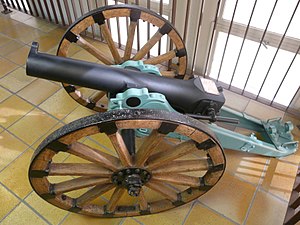|
7.5 cm Gebirgskanone L/13 C/80
The 7.5 cm Gebirgskanone L/13 C/80 was a mountain gun used by several countries during the late 1800s and early 1900s. Germany and the Ottoman Empire also used them during World War I. BackgroundDuring the late 1800s, Krupp became a major arms supplier and one of their better-selling product lines was mountain guns and Krupp sold 688 mountain guns to its customers before World War I. Many of its customers had mountainous borders which were sometimes ill-defined and often were in dispute.[3] The problem that Krupp's engineers had to solve was there was often a lack of roads and rail lines in mountainous regions and only narrow rocky footpaths existed. The field artillery of the time was designed to be towed by horse teams over gravel roads and then manhandled into firing position. Which was hard enough to do on flat muddy ground but became even more difficult when there was a lack of roads. Traditional field artillery could usually be broken down into separate wagon loads with the barrel on one wagon towed by a horse team while a second horse team towed the carriage. However, there was the issue of the gun crew being unable to reassemble the guns due to a lack of oxygen, cold temperatures, and weighed down with thick clothing.[3] What was needed was a gun that was light and could be broken down into multiple loads for transport by the gun crew and pack animals. Horses could carry more weight but were large and not always sure-footed. Mules were smaller, sure-footed, but were stubborn and carried less weight. After experimentation it was found that if a gun could be broken down into multiple loads a mule was capable of carrying a 100 kg (220 lb) load and the gun crews were able to reassemble and manhandle the guns into position.[3] However, the trade-off was mountain guns didn't stand up well to being towed when assembled due to their jointed designs. Also to keep weight down the guns were often small caliber with reduced propellant loads to reduce recoil and lacked range because their barrels were short to keep them light and portable.[3] DesignThe 7.5 cm Gebirgskanone L/13 C/80 was a breech-loaded mountain gun made of steel with a box trail carriage built from bolted steel plates, with two wooden-spoked steel-rimmed wheels. For transport, the gun could be dismantled into multiple mule loads or towed by a mule when assembled. There was no recoil mechanism, no gun shield, no traversing mechanism, and elevation was controlled by a jackscrew beneath the breech. Since it had limited elevation -10° to +20° it was a direct fire weapon meant to fire on troops in the open and the most common shell types were common, canister and shrapnel.[2] In 1891 a new heavier carriage was introduced which increased the angle of elevation to +23° which together with the switch from black powder to smokeless powder increased range and muzzle velocity. The heavier carriage improved towability as well as withstanding the greater recoil of new propellants.[1] The breech system differed depending on the customer but the projectiles were the same used by the Krupp 8 cm Kanone C/80 field gun. Argentina used a Maxim-Nordenfelt interrupted screw breech for their guns that used separate-loading bagged charges and projectiles. The projectile was loaded first then followed by bagged charges. While Germany, Chile, and the Ottoman Empire used a cylindro-prismatic breech that was a predecessor of Krupp's horizontal sliding-block. The cylindro-prismatic breech used separate-loading cased charges and projectiles. Bagged charges were first placed in a brass cartridge case and assembled with the projectile and then placed in the breech. The difference between the two was the interrupted screw breech provided the obturation to seal the breech while the cylindro-prismatic breech used the cartridge case to seal the breech.[2] Users and conflicts
Gallery
ReferencesWikimedia Commons has media related to 7.5 cm Gebirgskanone L/13.
External links |
||||||||||||||||||||||||||||||||||||||||||||||||||










